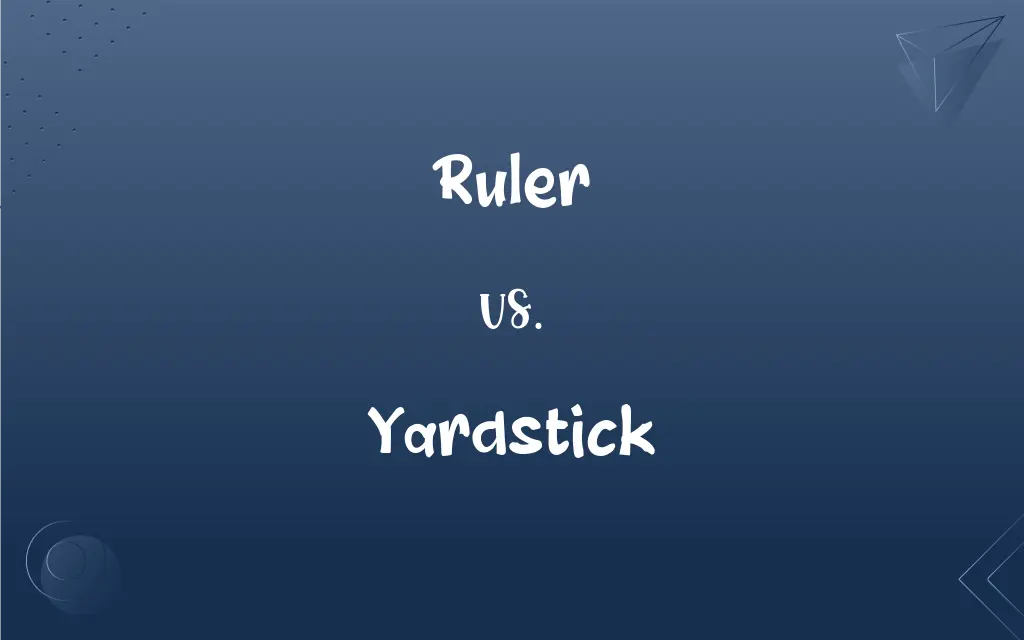Ruler vs. Yardstick: What's the Difference?
Edited by Aimie Carlson || By Janet White || Updated on March 4, 2024
Ruler is a tool for measuring length or drawing straight lines, while yardstick specifically refers to a ruler that is one yard long.

Key Differences
Rulers are measuring tools available in various lengths, typically marked with units of measurement such as inches or centimeters. They are commonly used in both educational settings and professional fields for drawing straight lines and measuring short distances. Yardsticks, on the other hand, are a specific type of ruler that measure exactly one yard (36 inches or about 91.44 centimeters) and are used for measuring longer lengths than typical rulers can accommodate.
While rulers can be made from a variety of materials, including plastic, metal, and wood, and come in different sizes, yardsticks are traditionally made of wood and are known for their longer, narrow shape. This makes yardsticks less portable and flexible than shorter rulers, which can easily fit into pencil cases or toolboxes.
Rulers are versatile tools used in a wide range of activities, from academic work like mathematics and drafting to crafts and construction. Yardsticks, due to their size, are more commonly used in sewing, tailoring, and construction projects where longer measurements are needed, making them less common in everyday academic settings.
The precision of measurement can differ between rulers and yardsticks. Rulers, especially those made from metal or high-quality plastic, can offer very precise measurements for detailed work. Yardsticks, while also precise, may be more subject to wear and bending over time, especially if made from wood, potentially affecting their accuracy.
Despite these differences, the term "yardstick" is also used metaphorically to mean a standard of comparison. This usage highlights how specific tools like yardsticks can become embedded in language and culture, transcending their literal functions.
ADVERTISEMENT
Comparison Chart
Length
Various, often 6 to 18 inches.
Fixed at 36 inches (1 yard).
Material
Plastic, metal, wood, etc.
Traditionally wood, but can vary.
Usage
Drawing lines, measuring short distances.
Measuring longer lengths, sewing, construction.
Portability
Highly portable, fits in pencil cases.
Less portable due to length.
Precision
High precision, especially in shorter models.
Precise, but may vary with material wear.
ADVERTISEMENT
Common Settings
Schools, offices, crafts.
Construction, tailoring, larger projects.
Cultural Significance
Standard measuring tool.
Metaphor for standard of comparison.
Ruler and Yardstick Definitions
Ruler
A device used to measure length or draw straight lines.
She used a ruler to ensure the lines were perfectly straight.
Yardstick
Often made of wood.
The wooden yardstick had measurements etched deeply into it.
Ruler
Made from plastic, metal, or wood.
His preferred tool was a metal ruler for its durability.
Yardstick
A standard used for comparison.
In performance reviews, his achievements became the yardstick for excellence.
Ruler
Ranges from 6 inches to several feet.
For her art project, she chose a 12-inch ruler.
Yardstick
Preferred in construction for its length.
To ensure the board's length, he measured it with a yardstick.
Ruler
Common in academic settings for teaching measurements.
Students learn to measure lengths using rulers in math class.
Yardstick
A measuring stick one yard long.
The tailor used a yardstick to measure the fabric.
Ruler
Ideal for detailed measurements in crafting and engineering.
The architect used a precise ruler for the blueprint.
Yardstick
Essential in measuring larger pieces of cloth.
She laid out the yardstick on the cloth to cut it straight.
Ruler
One, such as a monarch or dictator, that rules or governs.
Yardstick
A graduated measuring stick one yard in length.
Ruler
A straightedged strip, as of wood or metal, for drawing straight lines and measuring lengths. Also called rule.
Yardstick
A test, standard, or model used in measurement, comparison, or judgment.
Ruler
A (usually rigid), flat, rectangular measuring or drawing device with graduations in units of measurement; a straightedge with markings.
Yardstick
A measuring rod thirty-six inches (one yard) long.
Ruler
A person who rules or governs; someone or something that exercises dominion or controlling power over others.
Yardstick
(figuratively) A standard to which other measurements or comparisons are judged.
Ruler
(transitive) To beat with a ruler (as a traditional school punishment).
Yardstick
A stick three feet, or a yard, in length, used as a measure of cloth, etc.
Ruler
One who rules; one who exercises sway or authority; a governor.
And he made him ruler over all the land.
A prince and ruler of the land.
Yardstick
A measure or standard used for comparison;
On what kind of yardstick is he basing his judgment?
Ruler
Measuring stick consisting of a strip of wood or metal or plastic with a straight edge that is used for drawing straight lines and measuring lengths
Yardstick
A ruler or tape that is three feet long
Ruler
A person who rules or commands;
Swayer of the universe
FAQs
Are rulers only used in educational settings?
No, rulers are used in a wide range of settings, including education, crafts, construction, and more.
Why would someone use a yardstick instead of a tape measure?
Yardsticks provide a rigid, straight edge that can be preferable for certain tasks like drawing long lines or measuring on flat surfaces.
Is a yardstick more accurate than a ruler?
Accuracy can depend on the quality of the tool and its material; both can be highly accurate, but rulers, especially metal ones, might offer more precision for detailed work.
What is the main difference between a ruler and a yardstick?
The main difference is their length; rulers come in various lengths, while yardsticks are specifically one yard long.
Can yardsticks be made of materials other than wood?
Yes, while traditionally wooden, yardsticks can also be made from metal, plastic, or other durable materials.
Can a ruler be longer than a yardstick?
While less common, there are rulers longer than yardsticks, especially those used in specific professional or industrial contexts.
How do you store a yardstick?
Due to its length, a yardstick is often stored hanging on a wall or in a long drawer or shelf.
Is there a standard width for yardsticks and rulers?
There's no strict standard, but most rulers and yardsticks are 1-2 inches wide to ensure ease of handling and stability.
Why are metal rulers preferred for precision work?
Metal rulers are preferred for their durability and resistance to bending or chipping, ensuring consistent precision over time.
Why are most rulers made of plastic or metal instead of wood?
Plastic and metal are more durable and resistant to wear, bending, and environmental factors than wood, making them suitable for precise measurements.
What is the historical significance of the yardstick?
The yardstick has historical roots in tailoring and construction, where the standard measurement of one yard became integral to these trades.
Can a ruler and a yardstick have the same measurement units?
Yes, both rulers and yardsticks typically have measurement units like inches and centimeters marked on them.
Are there digital rulers or yardsticks?
Digital measuring tools exist, but traditional rulers and yardsticks remain popular for their simplicity and reliability.
What is the significance of having both metric and imperial units on measuring tools?
Having both metric and imperial units allows for versatility in measurements, accommodating international standards and preferences.
How do environmental conditions affect wooden yardsticks?
Wooden yardsticks can warp, swell, or shrink due to humidity and temperature changes, potentially affecting their accuracy.
How do schools use yardsticks in education?
Schools may use yardsticks in subjects like math and science to teach students about measurement, geometry, and physics principles.
Are there specialty rulers or yardsticks for specific industries?
Yes, there are specialty measuring tools, like quilting rulers or architects' scales, designed for specific tasks in various industries.
How is the term "yardstick" used metaphorically?
Metaphorically, "yardstick" refers to a standard or criterion by which other things are judged or measured.
How do you ensure the accuracy of a ruler or yardstick?
Accuracy can be ensured by checking for straightness, clear markings, and no physical damage, and by calibrating against a known measurement.
Can yardsticks be folded or collapsible for better storage?
Some yardsticks are designed to fold or collapse into smaller sections for more convenient storage and portability.
About Author
Written by
Janet WhiteJanet White has been an esteemed writer and blogger for Difference Wiki. Holding a Master's degree in Science and Medical Journalism from the prestigious Boston University, she has consistently demonstrated her expertise and passion for her field. When she's not immersed in her work, Janet relishes her time exercising, delving into a good book, and cherishing moments with friends and family.
Edited by
Aimie CarlsonAimie Carlson, holding a master's degree in English literature, is a fervent English language enthusiast. She lends her writing talents to Difference Wiki, a prominent website that specializes in comparisons, offering readers insightful analyses that both captivate and inform.































































